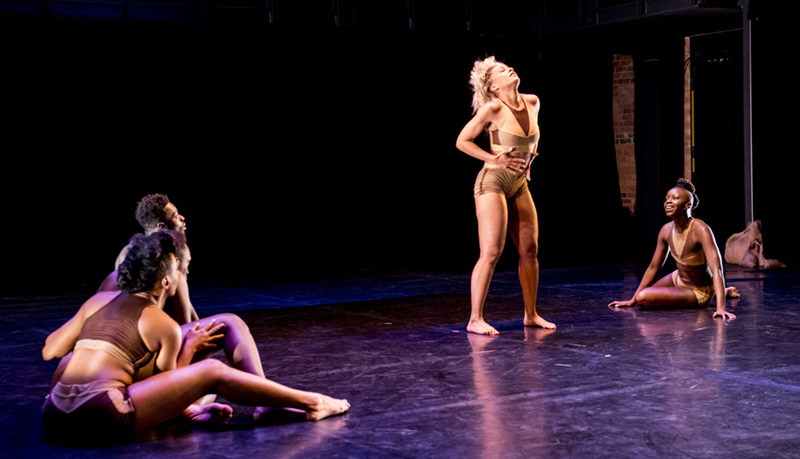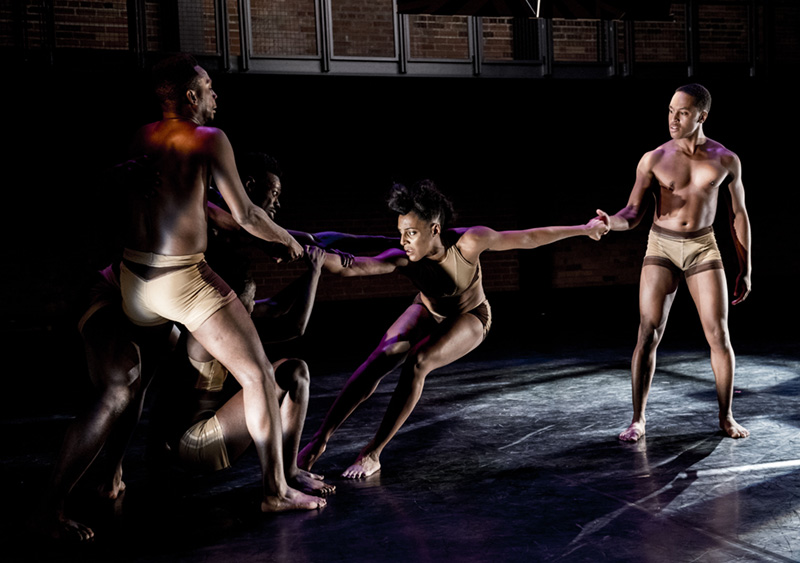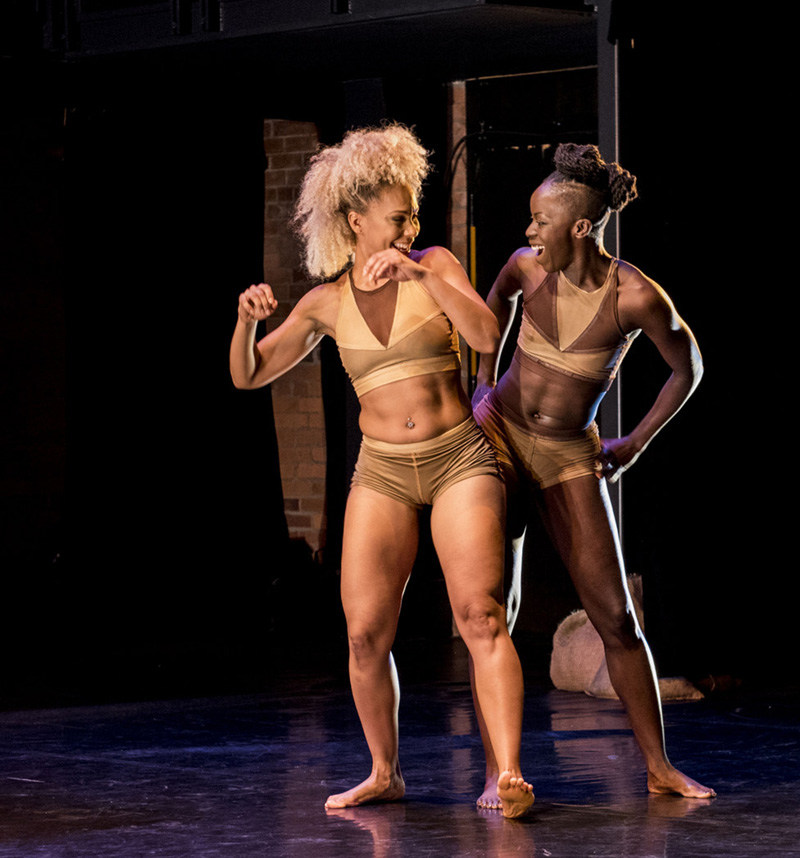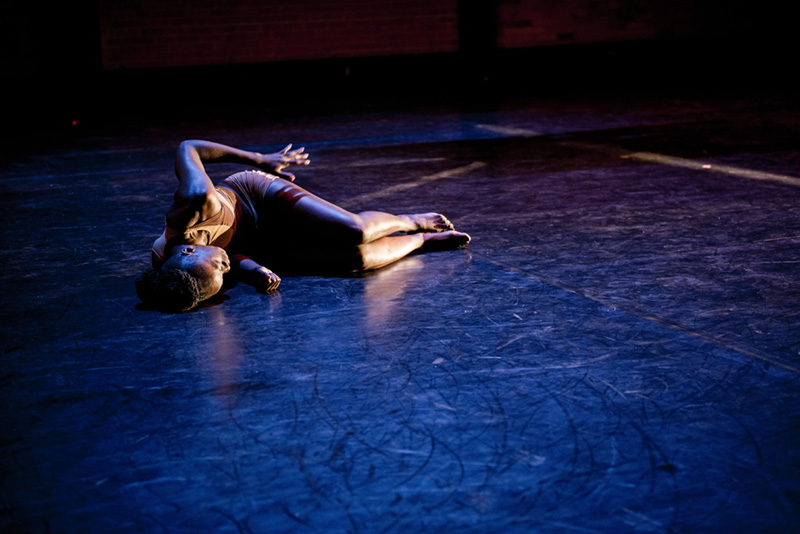Diving into The World of Shadeism
An Interview with Esie Mensah
BY EMMALY WIEDERHOLT
Photos by Ömer Yükseker
Esie Mensah is a dance artist, choreographer and movement director based in Toronto, Canada. Here, she discusses in depth her work, SHADES, which examines the effects of colorism – prejudice against a person based on the fairness or darkness of their skin color – in the Black community, and her extensive process revising and revisiting that theme from many different angles.
~~
Can you tell me a little about your dance history – what kinds of performance practices and in what contexts have shaped who you are today?
My journey in dance started in traditional Ghanaian styles. My family was committed to bringing our culture and the dances that represent my tribe and various tribes in Ghana into Canada. They started a recreational group, which I was part of. Different master teachers came to teach us various dances over the years. I was in that group from when I was born to when I was 17.
While I was in school, I did a year-long program through George Brown College to see if dance could become something more. It was a program for people who wanted to get into the commercial dance industry, which includes anything from cruise ships to movies. We studied ballet, jazz, contemporary, musical theater, acting, singing and hip hop. As soon as I graduated, I started my career in commercial dance.
About five years in, I had to face the reality of the industry in terms of not being able to get booked and feeling unrepresented. That experience shaped my trajectory as I moved out of the commercial world and into doing traditional West African dance. My teacher, Lua Shayenne, found me, and knew I had done traditional dance as a kid. She brought me into her company where I learned the styles of Mali and Guinea. That led me to create Afro fusion dance. Prior, I had done Afro house, Afro hip hop and Afro jazz, but once I started learning Guinea styles, I became intrigued by the movement itself and how it can transcend into other styles. I began a whole process of creating and experimenting with my own style of Afro fusion, which is the main form I create. I’ve been choreographing for about eight years.
My interest now is in engaging people and understanding the complexities of what African culture represents, especially in the context of Afro beat today. I want people to understand the spiritual side of the countries and tribes and their nuances that make up what Africa is. It’s not a monolithic idol, which a lot of people seem to think. I want to shift people’s perspectives, which is why education is really the base of my work.
How would you generally describe your choreography to someone unfamiliar with it?
I’m a complex artist and I do a lot of different things. It might be very high energy dance with Afro beat music, which is a shoo-in in terms of what the culture is. On the other end of the spectrum is my theatrical work, which is my movement and/or choreography mixed with theater. It gives me a chance to use the movement and form as a way of telling stories. If the music and movement of Afro beat and Afro fusion only live in the social media context, it’s going to die. I want to push beyond that and get people to see that these forms can be performed in any major theater across the world. People can resonate with it in the same way they do with ballet.
Can you tell me about your recent piece, SHADES, and how the piece came about?
The seed was planted from my experience in the commercial dance industry, particularly being a dark-skinned female in an industry that wants a certain type of Black woman. I was fighting for work, to be seen and recognized for quite a bit of time. It left me discouraged.
Fast forward years later after I started doing Afro fusion, I was in a remake of Rocky Horror Picture Show. I did the audition and killed it, as did some girlfriends of mine. I remember chatting with them after the callback, telling each other we each did great and wondering who they would choose. As Black women, we knew that the likelihood would be only two of us getting chosen, but they ended up picking all four of us. That never happens. There’s never that many Black women in a major movie production. After that film, I went on vacation and the experience lingered with me. I started doing research and delving into the world of colorism/shadeism. I wanted to understand better. Why is it the way it is? I created the first version of SHADES in 2016, and now I’m on version five. Every time I present it, it changes.
What was your work process for creating SHADES?
I didn’t recognize when I was creating SHADES that it was going to be a teacher. SHADES taught me what it needed to be, where I needed to go, and how it needed to be directed.
Each version kept uncovering the next piece. The version I created in 2016 was the beginning. From there, I began working with a director to make a documentary about SHADES, and one of the things the documentary did early on was allow me to have conversations on film, recognizing the experiences that the people around me all seem to be having but aren’t talking about. For almost a year, we were just talking with people. Those conversations seeped into my being.
I became intrigued with asking how we became so disconnected. If we didn’t start off this way and we saw each other as equal, no matter the complexion of someone’s skin, when did we disunify? Understanding that became my main intention for 2017. As the new version started to be uncovered, I realized how disabling the show was. It left with our bodies unable to transmit a message. It became pedestrian. How could I add movement into a piece like this when we’re all holding our baggage and getting weighed down? I could only do a gesture. I got sick around that time, and it gave me a chance to go back to the drawing board and figure out how to add more movement. In early 2018, we had another performance opportunity. It flowed a lot better, and I added music into it.
In the summer of last year, we started a new exploration with a dance dramaturg. She asked, “What does everybody have to say?” That led to movement explorations where each person was the focus. It was interesting to see, witness and understand everyone’s voice in relation to shadeism. Each person was able to speak through their own experiences. We would just play, but generational trauma would come up. We had to recognize that everyone’s hurt, stored within them, would crack and flood out. The process gave everyone a chance to get out their demons and the things they were too scared to release.
I had a chance to tell a light-skinned woman all the things I’ve experienced as a dark-skinned woman, even though she was not personally the source of what I had gone through. She ended up absorbing that, and it got ugly. The light-skinned girl started becoming the point of attack in terms of how we would speak to her. I thought I would lose my cast by the end of the week. I was very discouraged by the end of it, as I was left with more questions than answers.
As we were getting into doing the full-length show, I worked with my mentor, D’bi Young Anitafrika. She was able to ask the questions that I was too scared to ask in terms of how shadeism is upheld by patriarchy, colonialism, sexism and racism. She had us discuss it and break it down in order to take a mirror to our own lives.
For instance, one light-skinned girl said she hadn’t gone through anything. We asked, “Are you sure? Maybe you need to look closer?” When she did, she recognized the subtleties. Her family would warn her not go out in the sun for too long, so she wouldn’t get too dark. They would play with her nose to make it look more European.
My mentor had seen the version I made earlier, and commented that I had made myself the bully, not the light-skinned girl. She also told me there was nothing new in the story I was telling and that I needed to complicate the narrative. That statement shifted SHADES. The next four weeks were spent with the cast trusting we would get little bits of information that would help drive the piece. Within four weeks, we were able to pull the full narrative together to present version four of SHADES. We performed the piece for international presenters at the Fall for Dance North Festival.
Maybe three weeks before the presentation, a pivotal character within the original production dropped out. She had been the white-passing Black person, the fairest in the group. She had to drop out because she moved to the US for school. I had to recast her character, and the person who replaced her was the same complexion as the second lightest girl in the group (after the one who left). That recast changed the story line, so there was the same character but from two different worlds.
When we usually describe ourselves in terms of shade, we use terms like mocha, chocolate or caramel. In the piece, we wanted to use tangible things to describe ourselves, like rust. I was tar, the lightest girl who dropped out was pearl, and the second lightest was sand. When I did the recast, there were two sands, so it became a battle between two light-skinned girls and allowed us to look within shade. When we look at shade, it usually boils down to dark-skinned people having issues with light-skinned people. We don’t usually look within the shade. With the recast, we were able to ask: What is that tension, what does it look like if there’s another person who looks just like you? It allowed us to dismantle what shadeism is and to push people to see the complexities of why it’s damaging.
Can you share more about the cast? What were their backgrounds and how did you select them?
Three people have been in every version: Ronnie, Percie and Terika. When it came to the versions after that, I had to cut dancers and put myself into the work to save costs. When we presented the full work, I added dancers to make sure the full spectrum of shades was being represented. I had worked with all the dancers prior. It was important for me to find people of the right shade, as well as people who could handle a conversation like this. Everyone has a different dance background. Not everyone has done Afro based movement, but the majority do. In SHADES, it’s not a prerequisite. Most of the movement is explorative.
What kinds of reactions have you received from SHADES?
Tears. Weightiness. The show is done predominantly in silence, which forces the audience to dictate their own narrative. People can pull from their life experiences, like being 10 years old and ignoring a light-skinned girl wanting to be a friend. The audience is forced to have a conversation in their own head. Some people are not willing to do that, and those people find it difficult to watch the show. I’m fine with that; I’m not expecting to have a 100 percent approval rate. Many people want to have music as a distraction. As a choreographer, I’d rather not feed people but instead allow them to take a journey themselves.
What the audience feels is important to me. I like to do talkbacks after shows to find out how they are relating to the work and what resonates. In the version I did last year, talkbacks gave me the chance to ask what didn’t make sense from a creator’s standpoint. That allowed me to approach the newer versions with fresh eyes in order to make the piece clear all the way through.
Do you have a sense of where you’ll take your work next?
SHADES feels like a lifetime project in some way, shape or form. It’s going to be a constant piece in my career as I grow over the decades because it’s a potent conversation. Being able to bring that conversation to as many people as I can is important. I want to bring SHADES into different communities, do workshops, and allow people to experience the healing we’ve felt.
SHADES could also grow in terms of other iterations. It might turn into a trilogy. There’s so much information within this one topic alone. It’s very exhausting and rewarding. I keep getting a better understanding of how it is that I created this thing. I was walking blindly and trusting the path. Now, reflecting backwards on how I created this show, it’s been really affirming in terms of why this show is so special and necessary.
Any other thoughts?
I wanted to explore the topic of shadeism through dance, which is different from exploring it through words. Dance gives people the chance to hone into their bodies and emotions. When you have to move and react, it forces everyone to stay present and confront things in real time. How do you react to hate and love? There’s a lot of pain surrounding this topic. Working through it physically is important.
~~
To learn more, visit www.esiemensah.com.




